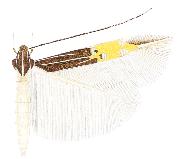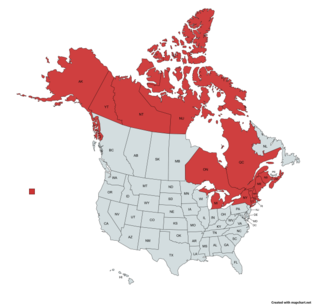
Toxomerus marginatus, also known as the margined calligrapher fly, is a common species of hoverfly. It is found in many parts of North America.

Cosmopterix minutella is a moth of the family Cosmopterigidae. It is known from Florida, United States.

Toxomerus politus, commonly known as the maize calligrapher, is a species of hoverfly. It is known from North, Central and South America. Although little is known about the early stages of this species, associations with corn have been noted. The adults and likely the larvae feed on the pollen of the corn plants.
Eupeodes rojasi is a species of hoverfly. It is named after Sergio Rojas, the administrator of the Subestación Experimental La Cruz (Chile). It feeds on Eriosoma lanigerum and is found in western South America.
Palpada megafemur is a species of flower flies. It is named after its particularly large metafemur. It is found in Brazil.

Brachyopa flavescens, The Yellow Sapeater, is a fairly common species of syrphid fly. It has been observed in northeastern North America. Hoverflies get their names from the ability to remain nearly motionless while in flight. The adults are also known as flower flies for they are commonly found around and on flowers, from which they get both energy-giving nectar and protein-rich pollen. Larvae for this genus are of the rat-tailed type. B.flavescens larvae have not been described.

Helophilus fasciatus, the narrow-headed marsh fly, is an abundant species of syrphid fly observed throughout the United States and Canada. Hoverflies can remain nearly motionless in flight. The adults are also known as flower flies for they are commonly found on flowers, from which they get both energy-giving nectar and protein-rich pollen. The larvae of this genus are associated with wet decaying organic material, particularly accumulations of decaying vegetation in ponds and mud and farmyard manure or silage. The adults of this species lays eggs on vegetation overhanging the water. The larvae hatch and drop into the water.

Helophilus lapponicus, the Yellow-margined Marsh Fly, is a common species of syrphid fly observed across northern North America, northern Europe, Greenland and Siberia. Hoverflies can remain nearly motionless in flight. The adults are also known as flower flies for they are commonly found on flowers, from which they get both energy-giving nectar and protein-rich pollen. Though common the larvae of this species are not known but the larvae of other species in this genus are associated with wet decaying organic material, particularly accumulations of decaying vegetation in ponds and mud and are a so called rat-tailed type.

Syrphus knabi, the Eastern flower Fly, is an uncommon species of syrphid fly observed in the eastern United States and Canada. Syrphid flies are also known as Hover Flies or Flower Flies because the adults are frequently found hovering around flowers from which they feed on nectar and pollen. Adults are 7.2–12.9 mm (0.28–0.51 in) long. The larvae are predators of a variety of aphids in trees.
Microdon tristis is a species of syrphid fly in the family Syrphidae.

Dasysyrphus intrudens is a placeholder name for a complex of hover fly species that have yet to be properly been divided into individual species. It is found in the Holarctic realm. Though this species actually a complex, it is commonly found in many areas of its range, but yet the larvae of this species were not known to science as of 2012. This may be due to the probable nocturnal habit of these larvae if it is similar to some known larvae of this genus.
Blera flukei, the red-cheeked wood fly, is a rare species of syrphid fly first officially described by Curran, 1953 as Cynorhina flukei. Hoverflies get their names from the ability to remain nearly motionless while in flight. The adults are also known as flower flies for they are commonly found around and on flowers, from which they get both energy-giving nectar and protein-rich pollen. The larvae are of the rat-tailed type, feeding on exuding sap or in the rot holes of trees.
Blera metcalfi, Metcalf's wood fly, is a rare species of syrphid fly first officially described by Curran in 1925 Hoverflies get their name from the ability to remain nearly motionless while in flight. The adults are also known as flower flies for they are commonly found around and on flowers from which they get both energy-giving nectar and protein rich pollen. The larvae are of the rat-tailed type feeding on exuding sap or in the rot holes of trees.
Sphegina (Asiosphegina) atrimanus is a species of hoverfly in the family Syrphidae found in Vietnam.
Sphegina bracon is a species of hoverfly in the family Syrphidae found in Vietnam along with specimens of S. (A.) lucida, S. (A.) nigrotarsata, S. (A.) spenceri, S. (A.) verrucosa, and S. (A.) vietnamensis.
Sphegina uncinata is a species of hoverfly in the family Syrphidae found in Myanmar. It's easily identified by a straight dorsal line of frontal prominence that ends just before the ocellar triangle, a strongly projecting mouth edge, and a vibrissal angle more strongly protruding than the frontal prominence.

Meromacrus gloriosus, the Glorious Elegant, is a species of syrphid fly in the family Syrphidae. Originally described from Mexico by Frank Hull in 1941 this black and yellow wasp mimic has since been observed in many locations in Texas and New Mexico.

Brachyopa caesariata, the Plain-winged Sapeater, is an uncommon species of syrphid fly. It has been observed in Canada, Alaska and northern United States. Hoverflies get their names from the ability to remain nearly motionless while in flight. The adults are also known as flower flies for they are commonly found around and on flowers, from which they get both energy-giving nectar and protein-rich pollen. Larvae for this genus are of the rat-tailed type. B.caesariata larvae have not been described.

Sphiximorpha willistoni, or Williston's wasp fly, is a rare species of syrphid fly found in eastern North America. It is a strong wasp mimic. Hoverflies can remain nearly motionless in flight. The adults are also known as flower flies for they are commonly found on flowers, from which they get both energy-giving nectar and protein-rich pollen. Larvae in this genus are found in sap runs of trees.

Dasysyrphus laticaudus, the boreal conifer fly, is a common species of syrphid fly observed in Eastern and Northern North America. Hoverflies can remain nearly motionless in flight. The adults are also known as flower flies for they are commonly found on flowers, from which they get both energy-giving nectar and protein-rich pollen. The larvae of this genus are aphid predators. .











